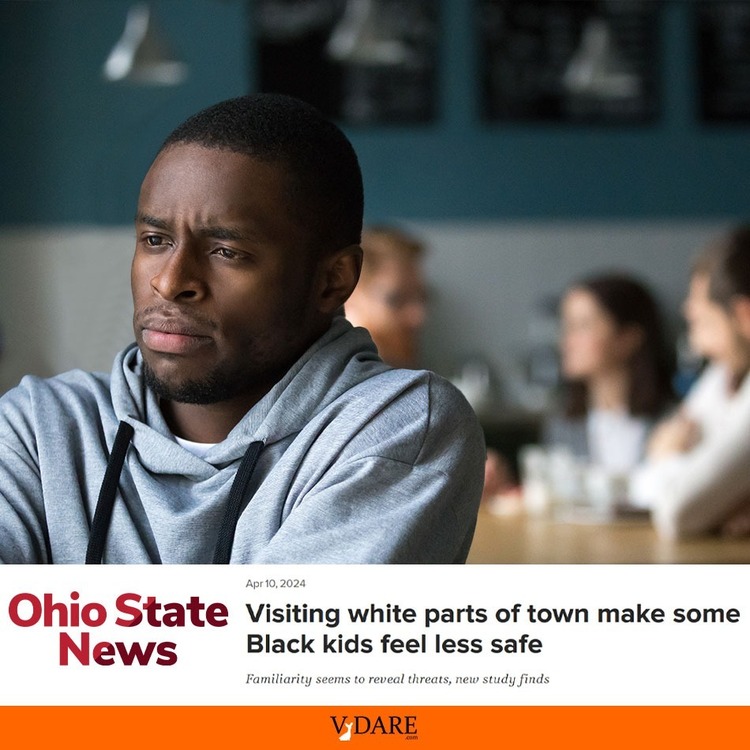An OSU study found that black kids visiting white parts of town—presumably in Columbus, Ohio—felt less “safe.”
Strangely, this same study doesn’t ask if when white kids visit predominately black parts of town, do they feel unsafe?
Visiting white parts of town make some Black kids feel less safe: Familiarity seems to reveal threats, new study finds, Ohio State University News, April 10, 2024
Some Black youth feel less safe when they visit predominantly white areas of their city, a new study in Columbus has found.
And it was those Black kids who spent the most time in white-dominated areas who felt less safe, said Christopher Browning, lead author of the study and professor of sociology at The Ohio State University.
“Familiarity with white neighborhoods doesn’t make Black kids feel more comfortable and safer. In fact, familiarity seems to reveal threats,” Browning said.
“It is not a terribly optimistic finding.”
The study was published online recently in the Journal of Adolescent Health.
The study is one of the first to examine racial differences in how urban youth perceive their safety in real time, Browning said. Data came from the federally funded Adolescent Health and Development in Context study, which involved 1,405 11- to 17-year-old youths in Columbus.
Researchers gave participants smartphones, which they used to report on how safe they felt as they moved through the city over a one-week period.
Five random times a day, the youths received a mini-survey that asked them where they were, what they were doing, who they were with and social characteristics of the setting. The GPS on their phone also recorded their location.
Each survey also asked them to rate on a 5-point scale if the location they were in was a safe place to be.
Researchers classified the youth as being in a white-dominated area if the census-block they were in when they were surveyed was at least 70% non-Hispanic white.
The study also measured violent crime levels in the areas that the youth visited.
Results showed that youth generally felt safe when they were near their homes – those who were within 30 meters of their home had about a 14% greater probability than others of strongly agreeing they felt safe in the moment.
Not surprisingly, both Black and white youth were less likely to say they felt safe when they were in census blocks that had higher violent crime rates.
But it was the racial differences that were of greatest interest to the researchers.
“When white youth are in white-dominated spaces, they tended to feel a little safer,” said Browning, who is also a member of Ohio State’s Institute for Population Research. “But that’s not the case for Black youth.”
The issue that Black youth face in Columbus and most other cities is that the resources they want and need—such as shopping, entertainment, libraries and restaurants—are often located in predominantly white areas.
Results of the study showed that Black youth who live in segregated, predominantly Black neighborhoods spend an average of 40% of their non-home time in white-dominated neighborhoods—about twice as much time as they spend in their own neighborhoods.
And the unsafe feeling for Black participants in the study increased with more exposure to predominantly white neighborhoods. For example, for teenagers exposed, on average, to 70% white neighborhoods, being outdoors in a white neighborhood reduced the probability of reporting strong agreement that the location was safe by about 26%.
“There is this complicated trade-off that Black youth have to navigate in which they want to take advantage of these organizational resources that are mainly available in white areas of the city,” Browning said. “But they also have to deal with feeling concerned about their safety.”
In order to keep the mini-surveys short, youth were not asked what led to their feelings of relative safety when they were in different parts of the city. But other research points to why Black youth would feel less safe in white-dominated areas of the city, he noted.
There is the fear of being the victim of racial violence or having a potentially dangerous encounter with police, which, while rare, is always possible, he said.
“But there is also the sense of psychological safety. We think of it as the sense of trust that Black youth have that they can be themselves and not be at risk of being excluded, which could include anything from microaggressions to outright discrimination,” he said.
This perception of being less safe in white neighborhoods may have real-life health consequences for Black youth. In a study published last year in the journal Psychoneuroendocrinology, Browning and colleagues measured hair cortisol concentrations in some of the same Black and white youths (690 total) involved in this research. High hair cortisol levels indicate elevated levels of chronic stress.
The findings showed that Black youth who perceived they were less safe also had higher levels of hair cortisol. Similar findings were not seen in white kids.
“We found that feelings of safety among Black kids predict this biological indicator of stress found in hair. High levels of chronic stress could have negative effects on health,” Browning said.
The results show the challenges that Black youth face living in American cities.
While a lot of attention has been paid to the problems Black youth face growing up in segregated neighborhoods, this study suggests that leaving those areas may present problems as well.
Here’s the question: Is there a study done to show how safe black kids are in a predominately white community versus how safe white kids are in a predominately black community? Conversely, how about black students attending a predominately white K-12 school versus a white student attending a predominately black K-12 school?
Again, we live in a society where every study commissioned by any institution has the stated goal of immediately making white individuals look collectively racist. It’s just another day in Black-Run America (BRA).













